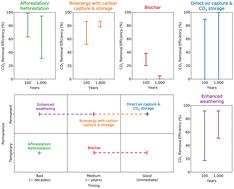当前位置:
X-MOL 学术
›
Energy Environ. Sci.
›
论文详情
Our official English website, www.x-mol.net, welcomes your feedback! (Note: you will need to create a separate account there.)
A comparative analysis of the efficiency, timing, and permanence of CO2 removal pathways
Energy & Environmental Science ( IF 32.5 ) Pub Date : 2022-09-14 , DOI: 10.1039/d2ee01021f Solene Chiquier 1, 2 , Piera Patrizio 1, 2 , Mai Bui 1, 2 , Nixon Sunny 1, 2 , Niall Mac Dowell 1, 2
Energy & Environmental Science ( IF 32.5 ) Pub Date : 2022-09-14 , DOI: 10.1039/d2ee01021f Solene Chiquier 1, 2 , Piera Patrizio 1, 2 , Mai Bui 1, 2 , Nixon Sunny 1, 2 , Niall Mac Dowell 1, 2
Affiliation

|
Carbon dioxide removal (CDR) is essential to deliver the climate objectives of the Paris Agreement. Whilst several CDR pathways have been identified, they vary significantly in terms of CO2 removal efficiency, elapsed time between their deployment and effective CO2 removal, and CO2 removal permanence. All these criteria are critical for the commercial-scale deployment of CDR. In this study, we evaluate a set of archetypal CDR pathways—including afforestation/reforestation (AR), bioenergy with carbon capture and storage (BECCS), biochar, direct air capture of CO2 with storage (DACCS) and enhanced weathering (EW)—through this lens. We present a series of thought experiments, considering different climates and forest types for AR, land types, e.g. impacting biomass yield and (direct and indirect) land use change, and biomass types for BECCS and biochar, capture processes for DACCS, and rock types for EW. Results show that AR can be highly efficient in delivering CDR, up to 95–99% under optimal conditions. However, regional bio-geophysical factors, such as the near-term relatively slow and limited forest growth in cold climates, or the long-term exposure to natural disturbances, e.g. wildfires in warm and dry climates, substantially reduces the overall CO2 removal efficiency of AR. Conversely, BECCS delivers immediate and permanent CDR, but its CO2 removal efficiency can be significantly impacted by any initial carbon debt associated with (direct and indirect) land use change, and thereby significantly delayed. Biochar achieves low CDR efficiency, in the range of 20–39% when it is first integrated with the soil, and that regardless of the biomass feedstock considered. Moreover, its CO2 removal efficiency can decrease to −3 to 5% with time, owing to the decay of biochar. Finally, as for BECCS, DACCS and EW deliver permanent CO2 removal, but their CO2 removal efficiencies are substantially characterized by the energy system within which they are deployed, in the range of −5 to 90% and 17–92%, respectively, if currently deployed. However, the CDR efficiency of EW can increase to 51–92% with time, owing to the carbonation rate of EW.
中文翻译:

CO2 去除途径的效率、时间和持久性的比较分析
二氧化碳去除(CDR)对于实现《巴黎协定》的气候目标至关重要。虽然已经确定了几种 CDR 途径,但它们在 CO 2去除效率、它们的部署和有效 CO 2去除之间的经过时间以及 CO 2去除持久性方面差异很大。所有这些标准对于 CDR 的商业规模部署至关重要。在这项研究中,我们评估了一组典型的 CDR 途径——包括造林/再造林 (AR)、具有碳捕获和储存的生物能源 (BECCS)、生物炭、直接空气捕获 CO 2通过这个镜头,具有存储 (DACCS) 和增强风化 (EW) 功能。我们提出了一系列思想实验,考虑了 AR 的不同气候和森林类型、土地类型,例如影响生物量产量和(直接和间接)土地利用变化,以及 BECCS 和 biochar 的生物量类型、DACCS 的捕获过程和岩石类型对于电子战。结果表明,AR 在提供 CDR 方面的效率很高,在最佳条件下可达 95-99%。然而,区域生物地球物理因素,例如在寒冷气候下近期相对缓慢和有限的森林生长,或长期暴露于自然干扰,例如温暖和干燥气候下的野火,大大减少了整体 CO 2AR的去除效率 相反,BECCS 提供即时和永久的 CDR,但其 CO 2去除效率可能会受到与(直接和间接)土地利用变化相关的任何初始碳债务的显着影响,从而显着延迟。Biochar 实现了低 CDR 效率,当它首次与土壤结合时,其 CDR 效率在 20-39% 的范围内,并且与考虑的生物质原料无关。此外,由于生物炭的衰变,其CO 2去除效率会随着时间的推移而降低至-3%至5%。最后,对于 BECCS、DACCS 和 EW 提供永久 CO 2去除,但它们的 CO 2去除效率的主要特征在于它们所部署的能源系统,如果目前已部署,则分别在 -5 至 90% 和 17-92% 的范围内。然而,由于 EW 的碳化率,EW 的 CDR 效率可以随时间增加至 51-92%。
更新日期:2022-09-14
中文翻译:

CO2 去除途径的效率、时间和持久性的比较分析
二氧化碳去除(CDR)对于实现《巴黎协定》的气候目标至关重要。虽然已经确定了几种 CDR 途径,但它们在 CO 2去除效率、它们的部署和有效 CO 2去除之间的经过时间以及 CO 2去除持久性方面差异很大。所有这些标准对于 CDR 的商业规模部署至关重要。在这项研究中,我们评估了一组典型的 CDR 途径——包括造林/再造林 (AR)、具有碳捕获和储存的生物能源 (BECCS)、生物炭、直接空气捕获 CO 2通过这个镜头,具有存储 (DACCS) 和增强风化 (EW) 功能。我们提出了一系列思想实验,考虑了 AR 的不同气候和森林类型、土地类型,例如影响生物量产量和(直接和间接)土地利用变化,以及 BECCS 和 biochar 的生物量类型、DACCS 的捕获过程和岩石类型对于电子战。结果表明,AR 在提供 CDR 方面的效率很高,在最佳条件下可达 95-99%。然而,区域生物地球物理因素,例如在寒冷气候下近期相对缓慢和有限的森林生长,或长期暴露于自然干扰,例如温暖和干燥气候下的野火,大大减少了整体 CO 2AR的去除效率 相反,BECCS 提供即时和永久的 CDR,但其 CO 2去除效率可能会受到与(直接和间接)土地利用变化相关的任何初始碳债务的显着影响,从而显着延迟。Biochar 实现了低 CDR 效率,当它首次与土壤结合时,其 CDR 效率在 20-39% 的范围内,并且与考虑的生物质原料无关。此外,由于生物炭的衰变,其CO 2去除效率会随着时间的推移而降低至-3%至5%。最后,对于 BECCS、DACCS 和 EW 提供永久 CO 2去除,但它们的 CO 2去除效率的主要特征在于它们所部署的能源系统,如果目前已部署,则分别在 -5 至 90% 和 17-92% 的范围内。然而,由于 EW 的碳化率,EW 的 CDR 效率可以随时间增加至 51-92%。



























 京公网安备 11010802027423号
京公网安备 11010802027423号